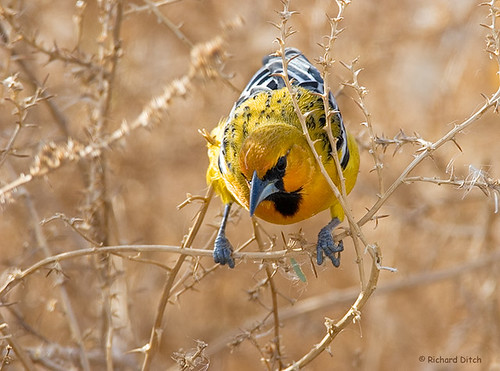tags: Streak-backed Oriole, Icterus pustulatus microstictus, birds, mystery bird, bird ID quiz
[Mystery bird] Streak-backed Oriole, Icterus pustulatus microstictus, photographed at the Water Ranch in Gilbert, Arizona. [I will identify this bird for you tomorrow]
Image: Richard Ditch, 15 December 2006 [larger view].
Please name at least one field mark that supports your identification.
Rick Wright, Managing Director of WINGS Birding Tours Worldwide, writes:
Any doubt that this is an oriole? Good. Confused about just what an oriole is? Better.
The English word was first applied, naturally enough, to an Old World species, the pleonastically named Eurasian Golden Oriole, Oriolus oriolus. Interestingly, although the name is clearly derived from Romance roots meaning "golden," in the thirteenth century Albertus Magnus claimed that it was instead echoic -- something that makes sense if you've ever heard the rich fluting of these colorful relatives of the crows, a song that can indeed be transcribed as "oriole, oriole."
By the late eighteenth century, the name had come to be applied in the Americas to an only distantly related group of yellow and orange birds, the colorful blackbirds also known as troupials. As a result, the English word "oriole" has no true taxonomic significance: it refers to the members of two widely separated families (or three, if you count the Oriole Whistler).
In Arizona, of course, we're dealing only with the troupial "orioles" of the family Icteridae. While in much of North America oriole identification isn't much of a challenge, the farther south and west you go, the more possibilities there are. All 30 or so species share the same general plumage pattern: yellow-to-chestnut bodies; dark back, wings, and tail; and some black on the head. Species of the temperate zones tend to be sexually dimorphic, with many females and young birds maddeningly dull, while in tropical troupials (say it three times fast) the sexes are more likely to resemble each other.
In diagnosing an unfamiliar troupial, it's best to try to focus all at once on all of the plumage areas listed above; a photo let's us do just that. Starting at the rear, we notice that this bird's tail is invisible--similar species can often be distinguished by their tail patterns (have a look at Baltimore and Bullock's Orioles), but we're out of luck here. Moving forward, we discover huge white tertial edges and what looks like a surfeit of white elsewhere in the wing; even though we can't determine the precise amount and distribution of white, this does let us rule out species with limited white or clearly defined white patches. The mantle is interesting. It's largely orange, with a pattern of fine but well-spaced streaks created by narrow black shaft streaks. Hooded Oriole, a species that may have sprung to mind on first glance, has a much more extensively black back than this bird, finely barred (not streaked) in the winter.
All is pointing towards Streak-backed Oriole, an identification confirmed by the bill shape and precise face pattern shown by this bird. The bill is huge at the base, thick throughout with a mean-looking point at the tip; Hooded Oriole's bill is slender and elegantly decurved, more like a shoemaker's needle than a claw hammer.
And note the way that the black on this Streak-backed Oriole's face narrows at the base of the bill, the orange of the malar almost reaching the lower mandible. Hooded Orioles have straight-edged black rectangles stuck on the front of their faces, while Streak-backed shows a heavy black lore just barely joined to a blotch on the throat.
The sparse streaking on this bird's back, along with geographic probability, let us assign this male to the northwestern subspecies microstictus, a common breeder just south of the US border but rare at any season in Arizona.


I'm going to call that an adult female Streak-backed Oriole. The streaked back, the "dark orange malar", and the lack of the first-year male Bullock's Oriole's "black eye-line" (Sibley), all push me in that direction. This bird also seems to have "extensive white on wings", which Bullock's also has, but at least based on Sibley's illustrations this bird's white looks closer to Streak-backed.
This is a bird I've never seen, but I think it's a male Streak-backed Oriole. The heavier bill, the black "beard" that extends down to the breast, heavily streaked back and the mere suggestion of a line behind the eye are the marks I
used.
Awesome image.